I live in a teeny-tiny apartment, so in anticipation of new releases that will be arriving, one of my end-of-2016 tasks was to go through the many books I read during the year and decide which ones I would add to my personal collection of children’s books. My goal was to keep only 10 books from 2016. Here are reviews of the 10 including notes on why I chose them. You’ll notice, however, that I cheated a bit by including a few pairings of a chosen book with other 2016 releases—in one case, getting eight picture books in one volume.
Ages 4–8
Curious George (75th Anniversary Ed.). H.A. Rey. 2016. Houghton Mifflin Harcourt.
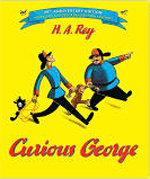 George, the good but curious little monkey, gets into a great deal of trouble between the time of his capture by the man with the yellow hat in Africa and his arrival at the zoo. Curious George,a picture book favorite from my childhood, will be shelved next to the new 2016 young readers edition of Louise Borden’s The Journey That Saved Curious George: The True Wartime Escape of Margret and H.A. Rey, originally published in 2005, which tells the story of how the Reys escaped Paris with the manuscript for Curious George in 1940, and Justin Martin and Liza Charlesworth’s Keep Curious and Carry a Banana: Wisdom From the World of Curious George (2016), a small book of pithy words to live by paired with illustrations from the original Curious George books.
George, the good but curious little monkey, gets into a great deal of trouble between the time of his capture by the man with the yellow hat in Africa and his arrival at the zoo. Curious George,a picture book favorite from my childhood, will be shelved next to the new 2016 young readers edition of Louise Borden’s The Journey That Saved Curious George: The True Wartime Escape of Margret and H.A. Rey, originally published in 2005, which tells the story of how the Reys escaped Paris with the manuscript for Curious George in 1940, and Justin Martin and Liza Charlesworth’s Keep Curious and Carry a Banana: Wisdom From the World of Curious George (2016), a small book of pithy words to live by paired with illustrations from the original Curious George books.
My Very First Mother Goose (20th Anniversary Ed.). Iona Opie (Ed.). Ill. Rosemary Wells. 2016. Candlewick.
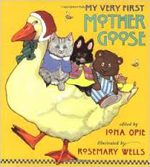 In the introduction, folklorist Iona Opie refers to Rosemary Wells as Mother Goose’s second cousin, a believable relationship for those who share this oversize collection of nearly 70 well-loved and lesser known traditional rhymes with young children. Wells’s whimsical watercolor illustrations feature her signature lovable animals (bunnies, cats, pigs, mice, and more, as well as an occasional human) taking on the roles of such characters as Jack and Jill, Little Boy Blue, Wee Willie Winkie, and the brave old duke of York. On its 20th anniversary, My Very First Mother Goose remains the perfect volume for introducing young children to the rhythms and words of Mother Goose. It will stay on my bookshelf until it becomes a baby gift.
In the introduction, folklorist Iona Opie refers to Rosemary Wells as Mother Goose’s second cousin, a believable relationship for those who share this oversize collection of nearly 70 well-loved and lesser known traditional rhymes with young children. Wells’s whimsical watercolor illustrations feature her signature lovable animals (bunnies, cats, pigs, mice, and more, as well as an occasional human) taking on the roles of such characters as Jack and Jill, Little Boy Blue, Wee Willie Winkie, and the brave old duke of York. On its 20th anniversary, My Very First Mother Goose remains the perfect volume for introducing young children to the rhythms and words of Mother Goose. It will stay on my bookshelf until it becomes a baby gift.
Tomi Ungerer: A Treasury of 8 Books. Tomi Ungerer. 2016. Phaidon.
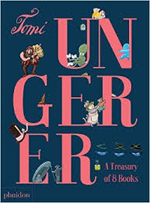 This beautifully formatted collection of eight of Tomi Ungerer’s picture books presented in a slipcase is indeed a treasure. After reading the eight books—The Three Robbers, Zeralda’s Ogre, Moon Man, Fog Island, The Hat, Emile, Flix, and Otto—readers new to his work will recognize Ungerer’s ability to craft picture book stories (some with unexpected choices of characters such as weapon-wielding robbers and ogres with an appetite for children) that are witty and thought provoking. Ungerer does not talk down to children even when his stories deal with important issues such as prejudice, social injustice, and war. The collection is introduced with a personal letter to readers from Tomi Ungerer. An appended “Behind the Scenes” section includes a conversation between Ungerer and his Phaidon editor about each of the books, along with preparatory sketches, storyboards, and photographs for the book, and a brief biography of the author. While serving on the United States Board on Books for Young People’s Hans Christian Andersen Award committee several years ago, I read as a widely as I could on the work of previous award winners. I learned that Ungerer, who won the Hans Christian Andersen Award for Illustration in 1998, had written more than 100 books, but I had access to only a few in English. How delighted I am to now have this treasury of Tomi Ungerer’s books to add to my children’s book collection.
This beautifully formatted collection of eight of Tomi Ungerer’s picture books presented in a slipcase is indeed a treasure. After reading the eight books—The Three Robbers, Zeralda’s Ogre, Moon Man, Fog Island, The Hat, Emile, Flix, and Otto—readers new to his work will recognize Ungerer’s ability to craft picture book stories (some with unexpected choices of characters such as weapon-wielding robbers and ogres with an appetite for children) that are witty and thought provoking. Ungerer does not talk down to children even when his stories deal with important issues such as prejudice, social injustice, and war. The collection is introduced with a personal letter to readers from Tomi Ungerer. An appended “Behind the Scenes” section includes a conversation between Ungerer and his Phaidon editor about each of the books, along with preparatory sketches, storyboards, and photographs for the book, and a brief biography of the author. While serving on the United States Board on Books for Young People’s Hans Christian Andersen Award committee several years ago, I read as a widely as I could on the work of previous award winners. I learned that Ungerer, who won the Hans Christian Andersen Award for Illustration in 1998, had written more than 100 books, but I had access to only a few in English. How delighted I am to now have this treasury of Tomi Ungerer’s books to add to my children’s book collection.
Where, Oh Where, Is Rosie’s Chick? Pat Hutchins. 2016. Simon & Schuster.
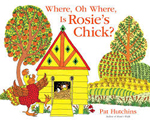 Rosie, the clueless hen who goes for a walk and unknowingly escapes from a fox again and again to arrive safely back home in Rosie’s Walk (1968), is once more meandering through the farmyard, this time searching for the newly hatched chick that she has lost. As the patterned illustrations in bright, fall colors show, Rosie, who is unaware that her chick (with half of the shell covering its head) is following her, unwittingly saves the chick from danger again and again. All ends well as the other hens inform Rosie that the chick is right behind her, and Rosie and her little chick go for a walk together. My copy of Rosie’s Walk now has the perfect companion.
Rosie, the clueless hen who goes for a walk and unknowingly escapes from a fox again and again to arrive safely back home in Rosie’s Walk (1968), is once more meandering through the farmyard, this time searching for the newly hatched chick that she has lost. As the patterned illustrations in bright, fall colors show, Rosie, who is unaware that her chick (with half of the shell covering its head) is following her, unwittingly saves the chick from danger again and again. All ends well as the other hens inform Rosie that the chick is right behind her, and Rosie and her little chick go for a walk together. My copy of Rosie’s Walk now has the perfect companion.
Ages 9–11
A Celebration of Beatrix Potter: Art and Letters by More Than 30 of Today’s Favorite Children’s Book Illustrators. 2016. Frederick Warne.
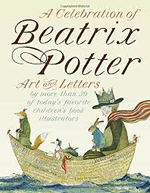 Thirty-two children’s book illustrators join in creating a celebration of the 150th anniversary of the birth of beloved children’s book author–illustrator Beatrix Potter. Introductory notes and excerpts of nine of Potter’s tales (presented chronologically by publication date) from The Tale of Peter Rabbit (1902) to The Tale of Mr. Tod (1912) are followed by original reimagined portraits of characters from the books by some of today’s favorite author–illustrators and reflective notes on early experiences with Beatrix Potter’s little books and how she inspired their work. Seeing which character the various illustrators selected to portray is interesting. My favorite entry: Tomie dePaola’s portrait of elderly Beatrix (Mrs. Heelis), who dePaola describes as resembling “the lovely, slightly cranky Mrs. Tiggy-Winkle,” having tea with the hedgehog laundress. This book is special to me because it includes the artwork of many of my favorite contemporary children’s book illustrators celebrating Beatrix Potter, whose books were my childhood favorites—and remain so to this day.
Thirty-two children’s book illustrators join in creating a celebration of the 150th anniversary of the birth of beloved children’s book author–illustrator Beatrix Potter. Introductory notes and excerpts of nine of Potter’s tales (presented chronologically by publication date) from The Tale of Peter Rabbit (1902) to The Tale of Mr. Tod (1912) are followed by original reimagined portraits of characters from the books by some of today’s favorite author–illustrators and reflective notes on early experiences with Beatrix Potter’s little books and how she inspired their work. Seeing which character the various illustrators selected to portray is interesting. My favorite entry: Tomie dePaola’s portrait of elderly Beatrix (Mrs. Heelis), who dePaola describes as resembling “the lovely, slightly cranky Mrs. Tiggy-Winkle,” having tea with the hedgehog laundress. This book is special to me because it includes the artwork of many of my favorite contemporary children’s book illustrators celebrating Beatrix Potter, whose books were my childhood favorites—and remain so to this day.
Find the Constellations. H.A. Rey. 2016. Houghton Mifflin Harcourt.
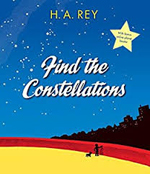 In Find the Constellations (first published in 1954), H.A. Rey uses a clear, accessible text and labeled diagrams and sky view maps to present a step-by-step guide on recognizing how groups of stars are arranged to form constellations and locating these constellations in the night sky. Sections of the book have been revised to include updated information on the solar system (including why astronomers now identify Pluto as a dwarf planet), and the Planet Finder chart now covers the years 2017–2026. Find the Constellations and Rey’s The Stars: A New Way to See Them (1952), which also has a new 2016 edition, remain the best introductions to astronomy for young people (and, in my opinion, for people of all ages).
In Find the Constellations (first published in 1954), H.A. Rey uses a clear, accessible text and labeled diagrams and sky view maps to present a step-by-step guide on recognizing how groups of stars are arranged to form constellations and locating these constellations in the night sky. Sections of the book have been revised to include updated information on the solar system (including why astronomers now identify Pluto as a dwarf planet), and the Planet Finder chart now covers the years 2017–2026. Find the Constellations and Rey’s The Stars: A New Way to See Them (1952), which also has a new 2016 edition, remain the best introductions to astronomy for young people (and, in my opinion, for people of all ages).
Under Water, Under Earth. Aleksandra Mizielińka & Daniel Mizieliński. 2016. Big Picture/Candlewick.
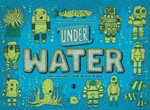 With brief text and detailed mixed-media cartoon illustrations with labels and captions, diagrams, and cross sections, this oversize volume takes readers on journeys of exploration of the worlds below the surface of our planet. As pages of Under Water are pored over, readers learn about the variety of creatures that inhabit the Earth’s lakes and oceans; properties of water related to underwater exploration such as buoyancy and pressure; special features such as coral reefs, sinkholes, underwater chimneys, and the Mariana trench; and the history related to diving suits, submarines, and other inventions that make underwater exploration possible. Each page takes readers deeper and deeper until the Earth’s core is reached. Then, flipping the book over to Under Earth, readers take a journey deep inside the Earth, exploring underground features, both natural and manmade, such as caves, tunnels, pipes and cables; creatures as varied as worms, ants, and burrowing mammals; archaeological and paleontological finds; mining operations; and explanations of tectonic plates, volcano and geyser formation, and the Earth’s layers. Under Water, Under Earth is too big to fit on a bookshelf, but it has a place nearby so that I (and inquisitive guests) can continue exploring below the Earth’s surface.
With brief text and detailed mixed-media cartoon illustrations with labels and captions, diagrams, and cross sections, this oversize volume takes readers on journeys of exploration of the worlds below the surface of our planet. As pages of Under Water are pored over, readers learn about the variety of creatures that inhabit the Earth’s lakes and oceans; properties of water related to underwater exploration such as buoyancy and pressure; special features such as coral reefs, sinkholes, underwater chimneys, and the Mariana trench; and the history related to diving suits, submarines, and other inventions that make underwater exploration possible. Each page takes readers deeper and deeper until the Earth’s core is reached. Then, flipping the book over to Under Earth, readers take a journey deep inside the Earth, exploring underground features, both natural and manmade, such as caves, tunnels, pipes and cables; creatures as varied as worms, ants, and burrowing mammals; archaeological and paleontological finds; mining operations; and explanations of tectonic plates, volcano and geyser formation, and the Earth’s layers. Under Water, Under Earth is too big to fit on a bookshelf, but it has a place nearby so that I (and inquisitive guests) can continue exploring below the Earth’s surface.
Ages 12–14
The Book Thief (10th Anniversary Ed.). Markus Zusak. Ill. Trudy White. 2016. Alfred A. Knopf/Random House.
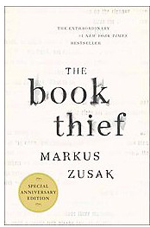 Death, the narrator, introduces The Book Thief as a story about a girl, some words, an accordionist, some fantastical Germans, a Jewish fist fighter, and quite a lot of thievery. The girl, Liesel Meminger, picks up her first book, The Gravedigger’s Handbook, in a snowy graveyard following the death of her younger brother, who has died while they are traveling to a foster home placement near Munich in 1939 Nazi Germany. Learning how to read with the help of her foster father, Hans Hubermann, is the beginning of Liesel’s love of words and her book thievery. This elegant 10th anniversary edition of Australian author Markus Zusak’s beautifully crafted novel includes a new introduction, excerpts from notebooks, handwritten notes on the manuscripts, and his original sketches for illustration, in addition to a Q&A. The “Anniversary-Edition Bonus Material” section at the end of this 2016 edition, which adds a wealth of information related to Zusak’s crafting of the book, left me looking forward to my next rereading of The Book Thief.
Death, the narrator, introduces The Book Thief as a story about a girl, some words, an accordionist, some fantastical Germans, a Jewish fist fighter, and quite a lot of thievery. The girl, Liesel Meminger, picks up her first book, The Gravedigger’s Handbook, in a snowy graveyard following the death of her younger brother, who has died while they are traveling to a foster home placement near Munich in 1939 Nazi Germany. Learning how to read with the help of her foster father, Hans Hubermann, is the beginning of Liesel’s love of words and her book thievery. This elegant 10th anniversary edition of Australian author Markus Zusak’s beautifully crafted novel includes a new introduction, excerpts from notebooks, handwritten notes on the manuscripts, and his original sketches for illustration, in addition to a Q&A. The “Anniversary-Edition Bonus Material” section at the end of this 2016 edition, which adds a wealth of information related to Zusak’s crafting of the book, left me looking forward to my next rereading of The Book Thief.
The Boy in the Striped Pajamas (10th Anniversary Ed.). John Boyne. Ill. Oliver Jeffers. 2016. Alfred A. Knopf/Random House.
 Oliver Jeffers’s illustrations add haunting visual images to this historical fable that explores the horrors of the Nazi death camps through the eyes of naïve 9-year-old Bruno, who moves in 1942 from Berlin to Auschwitz, where his father is the new Commandant. In his introduction to this 10th anniversary edition of The Boy in the Striped Pajamas, John Boyne references his interest in writing about “the manner in which war affects and destroys the experience of childhood, which is supposed to be a happy and carefree period, and what it means for a child to be thrust into an adult situation far ahead of time.” Boyne does this beautifully in his writing of The Boy in the Striped Pajamas and in The Boy at the Top of the Mountain (2016), the story of a young boy living in Adolf Hitler’s Austrian retreat.
Oliver Jeffers’s illustrations add haunting visual images to this historical fable that explores the horrors of the Nazi death camps through the eyes of naïve 9-year-old Bruno, who moves in 1942 from Berlin to Auschwitz, where his father is the new Commandant. In his introduction to this 10th anniversary edition of The Boy in the Striped Pajamas, John Boyne references his interest in writing about “the manner in which war affects and destroys the experience of childhood, which is supposed to be a happy and carefree period, and what it means for a child to be thrust into an adult situation far ahead of time.” Boyne does this beautifully in his writing of The Boy in the Striped Pajamas and in The Boy at the Top of the Mountain (2016), the story of a young boy living in Adolf Hitler’s Austrian retreat.
Ages 15+
Scythe (Arc of a Scythe #1). Neal Shusterman. 2016. Simon & Schuster.
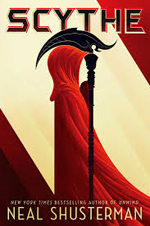 In a post–Age of Mortality world, death has been conquered. No one dies from hunger, disease, aging, or accidents. To control overpopulation, professional scythes (or reapers) “glean” citizens randomly following a set of commandments, the first of which is “Thou shalt kill.” In this first book in the Arc of a Scythe trilogy, 16-year-olds Rowan Damisch and Citra Terranova are chosen by Honorable Scythe Faraday to be apprentice scythes. As the two teens are pitted against each other in their training (only one will become a scythe; the other will be gleaned), they become aware that all is not perfect in MidMerican Scythedom. Scythe is a dark, disturbing thriller that raises moral and ethical issues for readers to ponder as they wait for the next book in the series. I’m keeping Scythe on my bookshelf, knowing I’ll want to reread it before I read the second book in the Arc of a Scythe series.
In a post–Age of Mortality world, death has been conquered. No one dies from hunger, disease, aging, or accidents. To control overpopulation, professional scythes (or reapers) “glean” citizens randomly following a set of commandments, the first of which is “Thou shalt kill.” In this first book in the Arc of a Scythe trilogy, 16-year-olds Rowan Damisch and Citra Terranova are chosen by Honorable Scythe Faraday to be apprentice scythes. As the two teens are pitted against each other in their training (only one will become a scythe; the other will be gleaned), they become aware that all is not perfect in MidMerican Scythedom. Scythe is a dark, disturbing thriller that raises moral and ethical issues for readers to ponder as they wait for the next book in the series. I’m keeping Scythe on my bookshelf, knowing I’ll want to reread it before I read the second book in the Arc of a Scythe series.
Carolyn Angus is former director of the George G. Stone Center for Children's Books, Claremont Graduate University, in Claremont, CA.
These reviews are submitted by members of the International Literacy Association's Children's Literature and Reading Special Interest Group (CL/R SIG) and are published weekly on Literacy Daily.